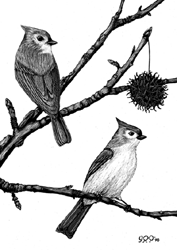In Season:
Tufted Titmouse on Winter Sweetgum
by Gary Pendleton
I joined seven old birders on January 2 for the Annapolis Christmas bird count. “What about the tufted titmouse?” one of the friends asked. “Is the plural titmice of titmouses?”
The tufted titmouse and chickadee are both members of the Paridae family, which consists of over 40 species worldwide. Paridae is the Latin word for titmouse. consists of over 40 species worldwide. Paridae is the Latin word for titmouse.
After the count, I visited the library to consult the Oxford English Dictionary. Tit comes from Iceland of all places. Deriving from tittr, it means something small. Mouse is from the Anglo-Saxon mase for little bird, according to Christopher Leahy’s authoritative The Birdwatchers Companion. Leahy and the OED part company on the proper pluralization, which is titmouses, according to Leahy.
Titmice (or mouses) have small crests like cardinals do. Hence the adjective tufted. Their colors are gray and white with a pale buff patch on their sides.
Many will recognize the sweetgum tree by its familiar spiky seed balls. This tree — found mainly in coastal areas, where it is quite common — is a good representative of Chesapeake country woodlands. The star-shaped leaves have a pungent scent when crushed. In fall, they display a brilliant range of colors: red, yellow, purple and green on the same tree. Sweetgum refers to the resinous sap, called liquidambar in Latin.
Copyright 2000
Bay Weekly
|